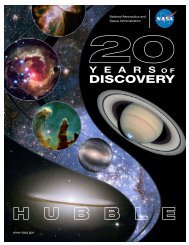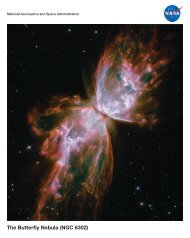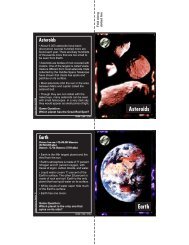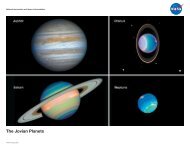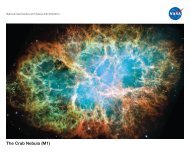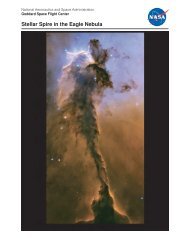Hubble Deep Field Activity - Amazing Space - STScI
Hubble Deep Field Activity - Amazing Space - STScI
Hubble Deep Field Activity - Amazing Space - STScI
You also want an ePaper? Increase the reach of your titles
YUMPU automatically turns print PDFs into web optimized ePapers that Google loves.
Science BackgroundGalaxies• Galaxies are massive systems made of billions of stars, dust, and gas clouds that are held togetherby gravity.• Stars are massive gaseous bodies that undergo nuclear reactions and emit light.Estimation• Astronomers have long tried to estimate the number of galaxies in the universe.• They use a method called “representative sampling” to obtain their estimate. They divide thesky into sections of equal size and count the number of galaxies in one section. They then multiplythe count from that one section by the total number of sections in the sky.• Astronomers have estimated the number of galaxies in the universe to be between 50 and 100billion.Shape• Astronomers use shape to classify galaxies.• There are three commonly recognized shapes: spiral, elliptical, and irregular.❏ Spiral galaxies have two or more “arms” winding out from a central disk. When viewedfrom the side, spiral galaxies look like fried eggs.❏ Elliptical galaxies appear smooth and featureless, with round or oval shapes, and appearbasically the same when viewed from any angle.❏ Irregular galaxies do not have arms or a uniform appearance. Their stars and gas cloudsare scattered in random patches.• The most difficult part about identifying galaxies by their shape is recognizing them when theirorientation is unknown.Color• Galaxies come in a variety of colors.• As a galaxy ages, its color changes.• Galaxies with young stars would appear blue; galaxies with old stars would appear red.• Galaxies with stars of varying ages may appear to be a combination of colors. For example, agalaxy with some old and young stars may appear to be a combination of blue and red.• The presence of dust in a galaxy can make it appear more red than it actually is.• By studying the light from a galaxy, astronomers can also get information about its chemicalcomposition, its distance from Earth, and the speed at which it is traveling away from us.12



